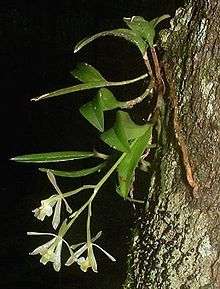Epidendrum magnoliae
| Epidendrum magnoliae | |
|---|---|
 | |
| Scientific classification | |
| Kingdom: | Plantae |
| (unranked): | Angiosperms |
| (unranked): | Monocots |
| Order: | Asparagales |
| Family: | Orchidaceae |
| Genus: | Epidendrum |
| Subgenus: | E. subg. Epidendrum |
| Section: | E. sect. Planifolia |
| Subsection: | E. subsect. Racemosa |
| Species: | E. magnoliae |
| Binomial name | |
| Epidendrum magnoliae Muhl. 1813 | |
| Synonyms | |
| |
Epidendrum magnoliae, sometimes called Epidendrum conopseum or the green-fly orchid, is a species of orchid in the genus Epidendrum. It is the most northern-growing epiphytic orchid in North America, being found wild in the southeastern United States from Louisiana to North Carolina, and also in northeastern Mexico (Nuevo León, San Luis Potosí, Tamaulipas).[1][2][3]
Epidendrum magnoliae grows on the branches of evergreen and deciduous trees at low elevations less than 100 m (330 ft) above sea level. Leaves are broadly elliptical, up to 10 cm (3.9 in) long, thick and almost leathery. One plant will produce 6-14 flowers, pale green to bronze-colored.[1]
The diploid chromosome number of E. magnoliae has been determined as 2n = 40, the haploid chromosome number as n = 20.[4]
References
- 1 2 Flora of North America, Epidendrum magnoliae Muhlenberg, 1813. Green-fly orchid
- ↑ Biota of North America Program 2014 county distribution map, Epidendrum conopseum'
- ↑ Hágsater, E. & G. A. Salazar. 1990. Orchids of Mexico, pt. 1. Icones Orchidacearum (Mexico) 1: plates 1–100.
- ↑ page 251 of Leonardo P. Felix and Marcelo Guerra: "Variation in chromosome number and the basic number of subfamily Epidendroideae (Orchidaceae)" Botanical Journal of the Linnean Society 163(2010)234-278. The Linnean Society of London. downloaded October 2010
External links
- Discover Life
- H. G. Reichenbach "ORCHIDES" in Müller, Carl, Ed. Walpers Annales Botanices Systematicae 6(1861)408. Berlin. Described as E. conopseum
- Epidendrum conopseum - Wildlife Resources Division, From: Patrick, Allison and Krakow (1995), Protected Plants of Georgia, Georgia Department of Natural Resources drawing, description, ecological information
- IOSPE photos photo
- Greenfly Orchids (Epidendrum magnoliae) in situ. video showing Epidendrum magnoliae in the wild in Florida
- Lady Bird Johnson Wildflower Center, University of Texas
- Atlas of Florida Vascular Plants, Epidendrum conopseum
| External identifiers for Epidendrum magnoliae | |
|---|---|
| Encyclopedia of Life | 1101206 |
| ITIS | 43559 |